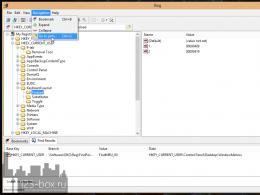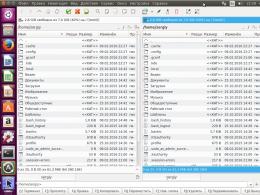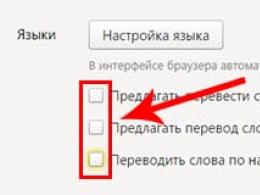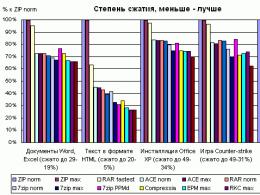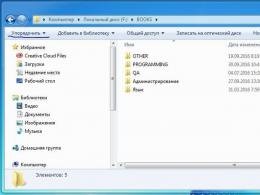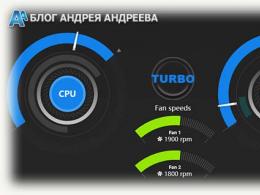Restoring desktop icons. SOS: Necessary shortcuts and notification area icons have disappeared from the desktop
At some point the user operating system Windows may find that all icons or, as they are also called, shortcuts, have disappeared on the computer desktop. There may be many reasons for this. In this article, we will try to figure out how to restore shortcuts to. As a result, four different methods will be presented to fix the problem.
Method 1: How to recover a deleted shortcut?
Perhaps this simplest way restoring desktop icons, however, it may not be effective in all cases, but only if they were deleted directly by the user himself. So, here's what you need to do for this:
- Open "Cart". If its shortcut also disappeared from the desktop, then you can do it like this: press Win + R, enter the command shell: RecycleBinFolder in the window that appears, click OK.
- In the window that appears, you should find all the removed shortcuts. Select all the items you need to restore.
- Press top panel the Restore Selected Items button.
After that, they should appear again on the desktop. If they are not in the Recycle Bin folder, then proceed to the next method on how to restore shortcuts on the desktop.
Method 2: Show icons feature
It happens that there are no problems by and large. This happens when the user simply turned off the display of icons on the main screen. It turns out that they all remained in place, just became invisible. By the way, you can check this by trying to select an area of the desktop by holding the LMB and dragging the mouse. If the selection area does not appear, then this is the reason. In that case, here's what to do:
- Right-click anywhere on the screen.
- In the menu, hover over the "View" item.
- In the additional menu, select "Show icons".

After that they should appear. This was the second way to restore shortcuts on the desktop, and it also can not always help, so let's move on to the next one.
Method 3: Run explorer.exe
Icons may also be missing due to the termination of the explorer.exe process, which is necessary to display almost all interface elements. To correct the situation, you need to do the following:
- Open the Task Manager window by pressing Ctrl+Shift+Esc on your keyboard.
- In the window that opens, click the "File" button and click on "New Task" in the context menu.
- In the window that appears, enter explorer.exe.
- Click the OK button.

The process will be launched, respectively, all desktop elements, including shortcuts, will be displayed. This method, how to restore a shortcut on the desktop, is also not considered one hundred percent effective, but it's still worth a try.
Method 4: Making changes to the registry
Using the previous method, it is not always possible to restore work. In this case, it is necessary to resort to making adjustments to system registry Windows.
- Open the registry by pressing Win+R and executing the regedit command.
- In the folder tree on the left, open HKEY_LOCAL_MACHINE and navigate to SOFTWARE.
- In the folder that opens, navigate to the Microsoft directory and then to WindowsNT.
- In it open CurrentVersion and then Image File Execution Options.
- Find explorer.exe or iexplorer.exe in the directory tree that opens and delete them. To do this, click on the name of RMB and select the appropriate item in the menu.

After that, you will need to restart your computer for all changes to take effect. Thus, after starting the desktop, the elements that were missing before should appear on it. So you have learned the fourth method of how to restore program shortcuts. If this did not help you, then there are only two options left: check the computer for viruses, perhaps they are preventing the icons from being displayed, or roll back the system to a time when the problem has not yet appeared.
We hope this article has helped you troubleshoot issues you've encountered while working in the operating room. Windows system. If none of the methods helped, then we recommend that you think about reinstalling the system.
Every user Windows organizes your desktop in a certain way, for quick access to popular applications and folders. The arrangement of labels (icons) in groups plays not only an aesthetic, but also a practical role, and when, due to system bugs or careless actions of the user himself, the usual order is violated, for many it becomes a small tragedy. Today I will tell you how to quickly restore the location of shortcuts using the command line or a portable special utility. ICU(Icon Configuration Utility).
![]()
Restore the location of icons on the desktop through cmd.exe
The easiest way to reincarnate the desktop is to use it, provided that you immediately noticed the changes and did not restart your computer. The fact is that information about the desktop layout is located in the registry key HKEY_CURRENT_USER\Software\Microsoft\Windows\Shell\Bags\1\Desktop, and if you close Explorer Windows forcibly, it will not save the data of the new template, but restore the old one upon startup.

Therefore, through the key combination " ", open the "Run" window and enter cmd → "OK" → in command line type (copy) taskkill /IM explorer.exe /F → "Enter(screenshot above).

After the Explorer has finished working, start it again by running the command in the console explorer , and make sure the icons are back in place.
Important!
If you have lost ALL shortcuts from your desktop, try this: click right click click on the free space, in the list, select " View" and check that the " Show desktop icons".
We restore the location of shortcuts on the desktop with the ICU utility

In order not to wait for problems, it makes sense to pre-write the desktop configuration in separate file. This is perfectly handled by a free portable (does not require installation!) software from the German developer Karsten Funk ( Karsten Funk).
Download ICU(Icon Configuration Utility) from my Yandex.Disk, transfer it to the folder of the same name and extract it from the archive. The principle is simple: to create configuration file in the application window, click the " Save" ("Save") → in the new window, give it a name → " Save".

Accordingly, to restore the usual location of shortcuts, activate ICU and after selecting the desired config, click " restore" ("Reestablish").

Despite the long absence of new versions, the utility supports both Windows 7, and Windows 8 / 10 any bit depth (32-bit / 64-bit).
Important!
If you have deleted some icon (shortcut) of the program and it is not in the "Trash", find the desired launcher EXE-file in directory C:\Program Files, click on it with the right mouse button and in the drop-down menu through the item " Send"select" Desktop (create shortcut)".
Dmitry dmitry_spb Evdokimov
How to restore icons on your desktop?
Master's response:
The disappearance of icons on the desktop can be caused by several reasons: a system crash or the operation of malicious software. Also, the user in the process of working with the computer, there is a need to restore previously deleted icons. This can be easily done using the "Task Manager", which is called upon any computer failure.
To do this, you will need a little: a computer, as well as a working mouse and keyboard.
Before you take decisive action, in order to restore the icons, try to do a few simple actions. Right-click on an empty space on the desktop and wait until it appears context menu.
If you suddenly accidentally deleted an icon, then in order to restore it, you must select "Cancel deletion" in the menu that appears. Also, you can go to the basket and restore all the icons you need. To do this, select all the icons you need, call the context menu by pressing the right mouse button and selecting the "Restore" item.
If you have lost all the shortcuts, icons and files on the desktop, and only the background image remains, then this is most likely caused by the failure of the Explorer.exe process, which is responsible for displaying them. Recovery this process you need to launch the "Task Manager" by pressing the Ctrl, Alt and Delete keys at the same time. Go to the Applications tab and click on the New Task button. Enter Explorer.exe in the box and click OK.
If the problem appeared after you downloaded and installed any software, then you need to use the function system backup(return to a few days earlier). To do this, launch the "Task Manager" and run a new msconfig task. Next, simply run System Restore and specify a restore point - up to the moment the suspected program was installed. Click on the "OK" button and restart your computer. This method, also, can help if there is nothing left on the desktop except the background image.
Often, when the Start menu or desktop icons disappear, deleting some files helps. Call "Task Manager" and run a new regedit task again. Next, go to Hkey_Local_Machine/Software/Microsoft/WindowsNT/CurrentVersion/Image File Execution Options and delete the explorer.exe and iexplorer.exe files. After that, restart your computer. This method should help you restore icons.
Some users are accustomed to keeping their own desktop (exactly like partitions on a hard drive) “clean”, structuring its contents, or even completely, indulging in the trend of minimalism, leaving up to 5-10 shortcuts in sight. Such organization in work is sometimes overshadowed by failures, after which it is found that all shortcuts from the desktop have disappeared.
This can happen due to incorrect settings or system problems. In any case, there is no reason to panic in this. We will explain why the shortcuts are gone and take a detailed look at the most effective ways out of the situation.
Icon display
- While on the desktop, you need to apply RMB to an empty area, initiating the appearance of the context menu. In the list, select the section "View", and then click on the option "Show desktop icons".
- After the actions taken, a “bird” should be displayed next to this option, and the labels themselves should appear at their previous location.
Accidental deletion
The reasons why shortcuts on the desktop disappeared may not be related to critical failures and malfunctions individual elements system, but with the banal inaccuracy of a person who mistakenly removed the shortcut (s). You can check the latter quite easily, simply.
To do this, click on the workspace of the RMB table, selecting the parameter "Create" in the drop-down menu, and in it clicking on "Shortcut".
An element should appear at the cursor location. New Label. In addition, a wizard for creating new shortcuts will open. It must specify the location of the file to which we want to configure quick access.
But you do not need to choose anything, we check! Just move the mouse around this window. If you have a shortcut on your desktop, but there are no familiar shortcuts, then you have enabled the display of icons, which was discussed in the first paragraph, but you still deleted your icons. This could have been done through negligence, or someone was just joking with you.
After you find out everything, the window for creating a shortcut can be closed using the Cancel button. And immediately start creating new icons.
Show hidden items
A variant is also possible, due to which all the labels did not disappear at all, but only received the hidden status. You can change everything back in the "Explorer" service.
- We start the service. To do this, just press the keyboard shortcut Win + E.
- Go to the directory "Desktop".
- Click on the option "View".
- Choose a section "Show or Hide".
- Put a tick on the option "Hidden Elements".
Launching Explorer
Few people know, but the explorer.exe system file is responsible for the appearance of all elements (shortcuts, taskbar, Start menu) on the desktop during OS boot. If his work fails and he stops showing up in the list of active tasks, then everything from the working the table will disappear. You can fix it like this:
- To start, we call "Task Manager"(by pressing the key combination Alt + Ctrl + Del , or through the Taskbar).
- In the menu, select the section "File", and in it click on the option "Start new task".
- In the task creation window, in the empty column, enter the name of the file explorer.exe.
By following the above steps, you initiate the correct appearance of the elements on the desktop.
Replacing a corrupted explorer.exe file
If during the diagnostics you found a malfunction of the explorer.exe executable application, we recommend that you replace it with a working copy. You can download a working file on the Internet (both in a separate form and as part of an installation theme for Windows 7, 8, 10), or move a copy of explorer.exe from a properly working system (the file location is indicated below).
- If there is a new file, we will replace it. The corrupted file is located in the C:/Windows/ folder. Having previously copied new version(command Ctrl + C ), paste it into the specified folder (Ctrl + V ), replacing the value.
- Now we need to restart the file. You can do this in the task manager (ALT + CTRL + DEL). Go to the "Details" tab and in the list presented we find "explorer.exe". We select it, and then select the option "End task" (the success of the process must be confirmed by the missing items on the desktop).
- Now run the replaced executable file(see point 2 and 3 of section "Launch Explorer").
System Restore
If you don’t know for what reason the icons disappeared, and the methods described above did not work, the work of viruses is most likely to blame and you need to restore the system.
Using the AVZ utility
For our task, the ideal assistant would be antivirus utility, which eliminates the consequences of work spyware and AdWare software.
- You can download the program on our website (link above), or on the developer's website. We start AVZ.
- In the menu, select the section "File", and in it we find the parameter "System Restore".
- In the settings window, select parameters 1; 5; 8-11; 16; 17. And then click "Perform marked operations".
- The program will start working, after which (after restarting the system) you will find the required shortcuts in their places.
Return to checkpoint
If, in addition to the missing shortcuts, serious failures are observed on your system, we advise you to “roll back” your OS to the last stable save point. This will allow you to "go back in time" to the point at which an unpleasant situation occurred, and prevent the malware that caused the problem from being affected. On our website you can find detailed materials describing how to carry out a similar procedure:
Changing settings in the registry
The last of the troubleshooting options discussed today is related to editing parameters in the Windows registry. This process should be resorted to last, since the slightest oversights made when changing the registry can affect the operation of the entire system so much that you have to install a “clean” Windows.
- First we need to call the standard service "Run". You can do this by pressing the Win + R keys at the same time.
- In the input column, paste the command regedit. Press the key "OK".
- In the registry editor that opens, follow the path: HKEY_LOCAL_MACHINE-SOFTWARE-Microsoft-Windows NT-CurrentVersion-Winlogon.
- In the "Winlogon" directory, we are interested in two keys:
- Shell must be explorer.exe
- Userinit is required to contain the path to the userinit.exe file, looking like this − C:\Windows\system32\userinit.exe.
If the values in the above paragraphs are distinct, correct them.
- Let's go along the path: HKEY_LOCAL_MACHINE\SOFTWARE\Microsoft\Windows NT\CurrentVersion\Image File Execution Options.
- In the left part of the window (navigation section) look for subsections explorer.exe / iexplorer.exe . If there are any, delete them by applying RMB to the subsection and selecting the option "Delete".
- Restart your computer to save changes.
Regardless of which troubleshooting method helped you, you need to make sure that you eliminate the root cause of the problem that occurred. It is recommended to scan the PC for malware, because otherwise, after restarting the system, it is quite possible that you will again encounter a situation where the icons from the desktop have disappeared again.
Rate article: (1
ratings, average: 5,00
out of 5)
Webmaster. Higher education in the specialty "Information Protection". Author of most articles and computer literacy lessons
Computer users store on the windows desktop (desktop) those icons, folders and shortcuts that are used every day and should always be at hand. The disappearance of all or only part of them may be the result of exposure to a virus or other malicious program. Another option is unskilled user actions. These two reasons are the main ones explaining why all shortcuts disappeared on the desktop. Fortunately, the task of how to restore desktop shortcuts is within the power of a user with basic computer knowledge.
The lack of shortcuts is inconvenient for the user. You can restore the missing shortcuts yourself.
Customizing system icons
After installing windows 7 on the desktop of the PC, the system icon "Recycle Bin" is already present. During the initial setup, as a rule, several others are added to it. This is almost always the "Computer" icon (in previous versions- "My Computer"), a folder with user files, sometimes the "Network" and "Control Panel" icons. How to restore the shortcut my computer and others? If shortcuts and folders have disappeared from the desktop, then it is easy to return them by implementing the following sequence of actions.


Why are there no shortcuts on the desktop even after these steps? The fact is that the display of Windows desktop icons is included in the functions of a special explorer.exe file that is launched when the computer is turned on along with the system. If the computer is seriously infected, the launch of this file is blocked. In this case, the checkboxes next to the components may be present, but the icons will not be displayed. How to return all shortcuts to the desktop? To solve the problem, you will need to restore the normal launch of the explorer.exe file.
Rollback to the previous state
By default, Windows provides the ability to return (rollback) to the previous state. In the course of work it is imperceptible for the user Current state remembered periodically. Such "snapshots" of the system are called recovery points. If necessary, the entire PC can be returned to a memorized state. If the shortcuts from the desktop have disappeared, then the easiest way is to return them by rolling back to the date when they were normally displayed. This will require several steps.


IMPORTANT. After that, you need to try not to repeat the steps, otherwise the icons may disappear again or disappear periodically. In particular, you should not ignore browser warnings about the potential danger of visiting certain sites. You may need to install a more advanced antivirus protection.
Unfortunately, on some computers, the very handy rollback feature is disabled to conserve disk space. Sometimes this disservice to customers is provided even during the pre-sale preparation of the PC.
Editing the Windows Registry
On a PC with the rollback function disabled, for the regular launch of the special explorer.exe file, you will have to edit the Windows registry. It is a huge database with hierarchically grouped parameters and operating system settings.
IMPORTANT. Editing should be done very carefully. With erroneous actions, an inexperienced user can seriously damage the system.
AT Windows registry you will need to edit the largest of its five sections - HKEY_LOCAL_MACHINE. To do this, a number of actions must be taken.


After rebooting the PC, the icons on the desktop will be restored.
Above, we discussed the restoration of shortcuts on the working windows desk 7. If shortcuts have disappeared from the desktop, not windows 7, but others modern versions- 8 and 10, then similar actions should be taken. There are also minor differences in the names of the icons. For example, if the shortcuts from the windows 10 desktop have disappeared, then after recovery, the user will see not “My Computer”, but “This Computer”.
NastroyVse.ru
Restoring desktop shortcuts
All PC users often experience problems related to the use of the computer. After the race various programs and their installation shortcut icons changed to "white sheet". Also, when you double-click on the shortcuts, the programs do not start. How to restore the normal operation of shortcuts in such a situation. To do this, perform the following steps. For the correct display of labels, special files are used that are fixed in the properties of labels. And if the shortcut icon has changed to a “white sheet” icon, then these files have somehow become corrupted. But don't worry. You can restore them quickly and easily.

What OS do you have installed?
pc-helpp.com
Restore desktop shortcuts
 If you are faced with the problem of restoring shortcuts on the desktop, then this article will help you in this matter and if you follow its instructions, you can quickly solve this problem.
If you are faced with the problem of restoring shortcuts on the desktop, then this article will help you in this matter and if you follow its instructions, you can quickly solve this problem.
Approximately this problem looks like this: “I downloaded three programs from the Internet and decided to test them in action. But after installing the second program, suddenly all the shortcuts on the desktop and in the Start menu changed their icons to a white blank sheet icon. Shortcuts stopped working - applications do not start. How to restore the functionality of shortcuts on the desktop?
Let's try to understand in as much detail as possible possible ways restore shortcuts.
Restoring desktop shortcuts
There are 2 main ways to restore shortcuts:
- Automatic, with special program.
- Manually through the computer registry.
Automatic shortcut recovery method
Free utility Unassociate File Types was created specifically for restoring system registry values and at the same time restoring the action of shortcuts.
- To do this, download the Unassociate File Types program and run it.
- After that, in the utility window, you need to find “.lnk” - select it and click “Remove file association (User)“

Now you need to restart your computer. After that, the problem should be solved.
We restore the work of shortcuts on the desktop manual mode
In order for shortcuts to be displayed correctly, certain files of a special type are fixed in their properties. If instead of a beautiful shortcut icon you see a blank sheet icon, then those very files of a special type are corrupted. With the help of this instruction, you should definitely cope with the problem that has arisen.
- Press the key combination “Win + R”, then type “regedit” in the command line and press Enter (or “OK“).

- In the window that opens, go through the registry tree: HKEY_CURRENT_USER -> SOFTWARE -> Microsoft -> windows -> CurrentVersion -> Explorer -> FileExts -> .lnk.
- Call the context menu by right-clicking on the UserChoice section (if available). In the menu that opens, select "Delete". Confirm your intention by clicking on the "Yes" button. Close the System Registry window.

Restarting the Desktop Using Task Manager
If after the steps to restore the desktop shortcuts, it will be faster for you to restart the desktop using the task manager, then you can try to do this using detailed description process.
In order to restart the desktop, carefully read the instructions to the end and copy explorer.exe to the clipboard (which will need to be launched with a new task in the manager), so after the process is turned off, the desktop and this instruction with the browser will not be available
In order for the changes made to restore shortcuts to take effect without restarting the computer, but after restarting the desktop, press the key combination “Ctrl + Alt + delete” - the main window of the Task Manager will open. Go to the Processes tab -> find among the list of processes “explorer.exe” –> select it and right-click to end the process (or select it, stop it using the “End Process” button located below) – after which the desktop will disappear along with labels.

- Next, in the same window of the Task Manager “” -> click on the file button, select “New Task”

- Now enter the command “explorer.exe” -> click on the “OK” button. Thus, we turned on the desktop.

How to restore the location of shortcuts on the windows 10 / 8 / 7 desktop
Each windows user organizes your desktop in a certain way, for quick access to popular applications and folders. The arrangement of labels (icons) in groups plays not only an aesthetic, but also a practical role, and when, due to system bugs or careless actions of the user himself, the usual order is violated, for many it becomes a small tragedy. Today I will tell you how to quickly restore the location of shortcuts using the command line or the ICU (Icon Configuration Utility) portable utility.
Restore the location of icons on the desktop through cmd.exe

The easiest way to reincarnate the desktop is to use the command line, provided that you immediately noticed the changes and did not restart the computer. The fact is that the information about the desktop layout is located in the registry key HKEY_CURRENT_USER\Software\Microsoft\windows\Shell\Bags\1\Desktop, and if you close windows explorer forcibly, it will not save the data of the new template, but restore the old one upon startup. Therefore, through the key combination "Win + R" open the "Run" window and enter cmd → "OK" → in the command line, type (copy) taskkill /IM explorer.exe /F → "Enter" (screenshot above).

After the Explorer is finished, start it again by running the explorer command in the console and make sure that the icons are back in their places.
Note: If you have lost ALL shortcuts from the desktop, try this: right-click on an empty space, select "View" in the list and check that "Show desktop icons" is checked.
We restore the location of shortcuts on the desktop with the ICU utility

In order not to wait for problems, it makes sense to write the desktop configuration in a separate file in advance. A free portable (does not require installation!) software from the German developer Karsten Funk will do just fine with this. Download ICU (Icon Configuration Utility) from my Yandex.Disk, transfer it to the folder of the same name and extract it from the archive. The principle is simple: to create a configuration file in the application window, click the "Save" button ("Save") → in a new window, give it a name → "Save".
Accordingly, to restore the usual location of shortcuts, activate ICU and, after selecting the desired config, click "Restore" ("Restore").

Despite the long absence of new versions, the utility supports both windows 7 and windows 8 / 10 of any bit depth (32-bit / 64-bit).
Note: If you have deleted some icon (shortcut) of the program and it is not in the "Trash", find the desired launching EXE file in the C:\Program Files directory, right-click on it and select "Send" in the drop-down menu select "Desktop (create shortcut)".
Dmitry dmitry_spb Evdokimov
TestSoft.su
Recovering a missing desktop in windows 7
 The order on the desktop is very good. All folders are in their places, labels are arranged on a grid, there is nothing superfluous. But sometimes such an “order” can appear unexpectedly and scare the user a lot, especially if all the shortcuts and even the taskbar disappear along with the Start button. To solve this problem, it is useful to know how to restore the desktop on windows 7.
The order on the desktop is very good. All folders are in their places, labels are arranged on a grid, there is nothing superfluous. But sometimes such an “order” can appear unexpectedly and scare the user a lot, especially if all the shortcuts and even the taskbar disappear along with the Start button. To solve this problem, it is useful to know how to restore the desktop on windows 7.
Run explorer.exe
You decided to install windows 7, made your wish come true, actively used the system, and suddenly, the next time you turned on your computer, you saw that instead of your desktop, a blank sheet appeared on the screen, not burdened with any shortcuts, gadgets and panels. What to do?

The explorer.exe file launches the windows graphical shell, so after turning it on, the desktop appears on the screen with all the shortcuts and the taskbar. The question arises why this system file will not start normally? Most likely, some malicious program changed the parameters of its operation, specified in the registry, while the file itself remained working.

To fix this error, perform a system restore, and then be sure to check your computer with an antivirus or a special cleaning utility, Dr.Web CureIT.
Important! If you decide to customize windows 7, do not disable the system restore feature. Creating and storing restore points, although it requires certain resources, can be extremely useful.
Using safe mode
If under normal windows boot"Task Manager" does not open or the desktop is not restored, you can try to follow the steps described above in safe mode.
Restart the computer and press the F8 key (to be sure, press it several times immediately after startup until the mode selection window appears). 
In the vast majority of cases, you will see your home screen with all the shortcuts and panels. You just have to go to the "Start" menu and select the "System Restore" item, which is located in the "Utilities" section. 
If the desktop is empty, call the "Task Manager" and try again to force the "explorer.exe" file to run.  Alternatively, you can immediately start System Restore by typing the “rstrui.exe” command.
Alternatively, you can immediately start System Restore by typing the “rstrui.exe” command.
After the system starts up normally, be sure to check it for viruses so that you do not encounter similar problems again.
Working with the registry
If the system restore function does not help (or was simply disabled), you will have to work a little with the registry, checking and, if necessary, correcting some of the entries responsible for starting the graphical windows shell 7.
- Boot in safe mode.
- If there is a Start button, click on it and open the Run menu. Enter the command "regedit" and click "OK".
- If there is no "Start" button, call the "Task Manager" (Ctrl + Alt + Delete), open the "File" menu, select the "New Task" item and enter the "regedit" command.
In the registry editor, you need to check several branches. First go sequentially along the path HKEY_LOCAL_MACHINE→SOFTWARE→Microsoft→windowsNT→CurrentVersion→Winlogon.
Check the "shell" parameter - it should be set to "explorer.exe".
As you can see in the screenshot, in this case, the value of the parameter is different, so instead of a graphical shell, the system launches a malicious application that is located in the “temp” directory.
If you launch the "Task Manager" and carefully read the "Processes" tab, then among other running applications you can easily find that malware found in the registry. 
Then check the "userinit" parameter - it should be set to "C:\windows\system32\userinit.exe". In the presented screenshot, you can see that the system accesses the "temp" folder, launching a malicious application.
To correct these shortcomings, it is necessary to bring the value of the "shell" and "userinit" parameters back to normal. The resulting entries should look like this: 
The next registry branch to check is HKEY_CURRENT_USER→Software→Microsoft→windows→CurrentVersion→Policies→Explorer. If you see a "NoDesktop" setting here with a value of "1", change it to "0" or just delete it. 
Finally, you can search by the name of the virus that you found in the value of the "shell" and "userinit" parameters.
Press Ctrl+F in the registry editor and start the search by typing the name of the malicious application in the line.
If you find a "shell" parameter on the HKEY_CURRENT_USER→Software→Microsoft→windowsNT→CurrentVersion→Winlogon branch that has some path in its value, edit it. By default, the value of the "shell" parameter should be empty. 
Registry recovery
In order not to correct entries manually, you can use the restore function windows registry 7. If you save a working registry configuration in advance in special file with the *.reg extension, you can easily return all the correct parameters if necessary.
But even if you have system restore turned off and you have not made copies of the registry, you can use the standard windows tools, which allow you to return the records to their original state.
Every 10 days, the registry is automatically saved in the form of several files that can be found in the "RegBack" folder.

Now you need to delete the registry files from the "Config" directory and copy in their place backups from the RegBack directory.  As a result, the registry will take on its normal, working form, in which no malicious applications will interfere with the correct display of the desktop.
As a result, the registry will take on its normal, working form, in which no malicious applications will interfere with the correct display of the desktop.
Restoring system files
Above, we considered the situation when the explorer file itself is not damaged, and changes were made only to the system registry. However, it also happens that recovery is required by the application itself, which is responsible for launching the shell.
To restore explorer.exe, follow these steps:

A computer scan will start, as a result of which system files will be searched for and restored. At this stage it may be necessary installation disk so prepare it ahead of time.
However, explorer.exe errors are usually fixed by the system itself, so you only need to wait for the scan to finish, after which you can start checking the registry.
AVZ Utility
Reestablish system files is possible not only with the built-in windows tools, but also thanks to the AVZ utility. If you can’t start the program with standard two clicks, open the Task Manager and select the New Task item from the File menu. 
Important! In the launch line, you must specify not the name of the utility, but the full path of its storage. For example: C:\Users\Username\Desktop\avz4\avz.exe.
The main program window will open. Expand the "File" menu and select "Update databases". 
Wait for the update procedure to complete and click OK. Open the File menu again and select System Restore. 
Check items 9 and 16 (“Remove debuggers” and “Restore startup key”) and click “Perform marked operations”.  After finishing work AVZ utilities it is necessary to check the registry and, if necessary, correct the entries using the instructions indicated above.
After finishing work AVZ utilities it is necessary to check the registry and, if necessary, correct the entries using the instructions indicated above.

